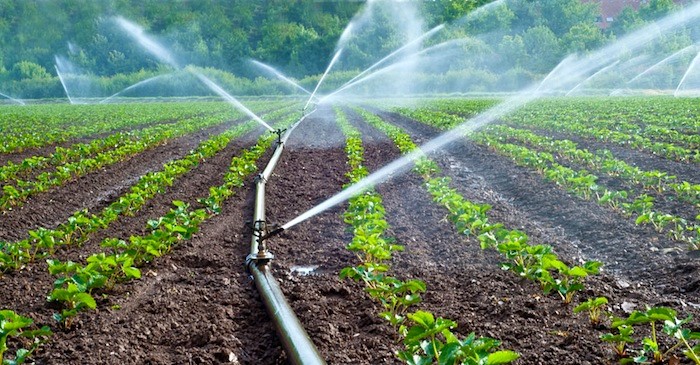As the largest contributor to Ghana’s Gross Domestic Product (GDP), accounting for over 50% of GDP, agriculture is essential for the country’s overall economic development. In addition, it generates roughly 60% of export revenue. It economically supports 80% of the people, whether directly or indirectly, through farming, the sale of farm goods, and other services to the agricultural industry (MOFA, 1991).
Irrigation is a crucial component required for the modernization of agriculture in Ghana. Unfortunately, the overall area under irrigation as of 1996 was expected to be only 11,000 hectares, or 0.26% of the total area under cultivation (Sant’ Anna, 1997). Memuna and Cofie (2005) state that this has been little change. This supports the reality that, despite higher yields and twice-yearly cropping on specific irrigated schemes, agriculture is primarily rainfed and subject to the whims of the weather and climatic changes.
Smallholder farmers, i.e. owners of farm plots less than two hectors, according to Nagayets (2005), are the custodians of 85% of all farms worldwide, accounting for 50% and 75% of the world’s hungry people worldwide and in Africa, respectively (Sanchez and Swaminathan 2005).
However, agricultural output and smallholder farmers’ livelihoods in Africa are severely hampered by various difficulties that exacerbate food security, such as climatic changes, disease and pest invasions, post-harvest losses, market shocks, and a lack of capital/credit, among others (Morton 2007).
Climate change is expected to intensify the predicament of smallholder farmers, according to new research, which predicts that even minor temperature rises will severely impact the output of major cereal crops grown by smallholder farmers, such as maize, rice, and wheat (Morton 2007). Moreover, tropical nations, such as those in Africa, with already large populations of impoverished and smallholder farmers, are projected to be the hardest hit by the effects of climate change (Hertel and Rosch 2010).
For instance, Ghana, a country with a land size of 238,540 km² (92,101 mi²) and a total coastline of 539 km (334.9 mi²), is enriched with lots of resources (human capital, land and minerals). It is primarily an agricultural nation, with the vast majority of its citizens working in agriculture either directly or indirectly.
Ghana has reasonably decent and necessary resources for the growth of agriculture, biodiversity, water resources, minerals, etc. Still, it nevertheless struggles with complex poverty that is widespread, deep, and systemic. This can be attributed to the fact that, like many “smaller” countries around the world, smallholder family farms that are predominately rainfed and hence climate-sensitive make up the majority of the agriculture industry in Ghana (Nyantakyi-Frimpong & Bezner-Kerr, 2015); Stanturf et al., 2011).
According to the harvest area, cassava, maize, groundnuts, and sorghum are a few of the nation’s top agricultural products (Choudhary & D’Alessandro, 2015). This calls into sharp focus the need to assess the impact of climatic changes on our agriculture and explore further “irrigation farming” instead of the “rainfed” agriculture in Ghana.
To develop resilience, one must comprehend the threat climate change poses to Ghana’s agricultural industry. Precipitation that is unpredictable and changeable, rising temperatures, and prolonged dry spells are only a few effects of climate change on Ghanaian agriculture.
In some places, especially in the Northern regions of Ghana, where 80% of the indigenes are mainly farmers (Ghana Statistical Service 2013), research has found that delays in the start of the rainy season, severe droughts and climatic variability have significant implications on agriculture. Thus, in general, and for some time now, in Ghana, rainfall patterns have been unpredictable and unevenly distributed throughout the seasons.
As a result, agroecology regions have poor yields, low productivity, food insecurity, and poverty in the farming community. This highlights the need to transition from manual, rainfed, supply-driven, and production-oriented agriculture to mechanized, irrigated, market-oriented agriculture that is technology-heavy.
Thus far, Rainfed Agriculture denotes a farming system that relies on rainfall for water. This has been the most widely used farming method worldwide, especially in the “poorer” nations. Although the importance of rainfed agriculture varies by area, it provides most of the food for underprivileged populations in developing countries.
For example, more than 95% of the agricultural land in sub-Saharan Africa is rainfed, compared to over 90% in Latin America, 60% in South Asia, 65% in East Asia, and 75% in the Near East and North Africa (Meenakshi., 2020). In Ghana, and especially in the Northern Zones, where the poverty level is three times their Southern counterparts, rainfed agriculture serves as a survival mechanism rather than a growth-oriented activity.
Moving on, the following features are characteristic of rainfed agricultural areas in the semi-arid, arid and sub-humid agro-ecological zones:
Certainly, rainfed agriculture will continue to be the only food source for some regions of the world and some parts of Ghana. Such a farming system is faced with numerous restrictions created by the wide variety in climate, soils, relief, and geography, as well as by anthropogenic changes.
Rainfed areas also need to contend with several grave hazards. Today, most rainfed areas are farmed utilizing outdated, traditional, and undeveloped methods for managing soil and crops, according to Rashid et al. (2004). The main obstacles are soil erosion, credit shortage, moisture stress and uncertainty, and nutrient depletion.
Consequently, agriculture in rainfed areas continues to be high risk and low input for farmers with little resources due to the unpredictable nature of the weather. Low yields in certain places could be ascribed to lousy crop management techniques, inadequate and unbalanced fertilization, and low seed quality. In addition, excessive runoff, outdated and traditional land and water management methods, and fragmented property holdings may cause low water use efficiency.
Therefore, crop yields are far below their demonstrated possible potential. Also, improper soil conservation practices can negatively impact the productivity of land resources, e.g. excessive cultivation on steep slopes, short fallow periods, cultivation in vulnerable areas, shallow tillage, uneven fertilizer use, and illogical irrigation practices (Irshad et al., 2007).
On the contrary, and in light of sustainability and sustainable farming, the focus has been shifted to the use of technology and practices that can improve productivity for farmers and, at the same time, protect the environment. This is why “irrigation farming” is what the world is currently driving at or is encouraged to drive at in the quest to ensure sustainability.
According to FAO (2005), Ghana has a potential for 360,000 ha of irrigable land. Earlier estimates by Agodzo and Bobobee (1994) put the area above 500,000 acres. I estimate that there are currently more than 2 million hectares. Whether the systems use pumps and gravity alone, pumps plus sprinklers, or just gravity, determined these estimations.
The more advanced and computerized drip irrigation system, the well-liked surface irrigation system, or even a watering can might be used for irrigation. However, the extent to which the definition of irrigation is used to determine irrigable potential raises questions about its viability.
Irrigation can then be defined as the artificial delivery of water to the soil using a variety of tube, pump, and spraying systems. Within areas that have dry spells, potential drought or erratic rainfall, it is not uncommon to see the extensive use of irrigation. There are many different kinds of irrigation systems, where water is distributed evenly across the entire field. Surface water from rivers, lakes, or reservoirs, groundwater from springs or wells, and even water from other sources like treated sewage or desalinated water can all be used for irrigation.
Against this background, world food and economic development have both benefited greatly from irrigated agriculture (FAO, 2003; Mukherji, 2009; Valipour, 2015). However, Ghana’s cases are slightly different ( Kyei-Baffour 2011). Thus, in Ghana, the poor performance of irrigated agriculture has frequently been attributed to ineffective water distribution, subpar operation and maintenance (O&M), disorganized irrigation support services, an unfavourable agricultural marketing system (Laube, 2007), ineffective teamwork, and feeble extension support system.
Nonetheless, according to the Ghana Irrigation Development Authority, stakeholders are collaborating to manage irrigation sustainably, taking into account the contribution of irrigation in semi-arid and arid areas as well as the rising issue that impacts it (GIDA, 2022).
The impact of irrigation agriculture, as opposed to rainfed agriculture cannot be over-emphasized. Valipour, M. (2013) postulates that; water resources are scarce in many parts of the world, and irrigation is not cost-effective. Pressurized irrigation uses less water than surface irrigation even though the effectiveness of the irrigation is high. Regardless, the cost of the pressurized approach is very high. Therefore, agricultural integration is a cost-effective strategy.
Additionally, the adoption of surface irrigation in small farms was a result of improved irrigation efficiency. To this end, as opposed to rainfed agriculture, a variety of factors must be taken into account when choosing an irrigation system. These will differ from one place, one crop, one year, and one farmer to another, making the practice of irrigation tedious and capital-intensive.
To sum everything up, 80% of agricultural production is from rainfed areas. However, climatic change and erratic rainfall patterns in contemporary times have necessitated a need for a more sustainable way. Increasing irrigated agriculture is therefore necessary.
In Ghana, agriculture continues to be the highest contributor to GDP, so the sector has received numerous support to manage the irrigation system. Although, despite these efforts, rainfed agriculture continues to be the most widely used. The inability to control or extend irrigation systems to all parts of the regions has sometimes been attributed to inadequate water supply.
That said, this article has highlighted the definitions, pros and cons of both rainfed agriculture and irrigation farming. A reliable and appropriate irrigation system (surface-based or pressurized) can increase irrigation effectiveness and agricultural output as opposed to rainfed agriculture. Therefore, numerous studies have been conducted to improve and maintain irrigation efficiency.
I hope you enjoyed the read. Hit me up, and let’s keep the conversation going! I read all the feedback you send. Also, feel free to throw at me topics you’d like to read or hear my thoughts on. You can always head to my Calendly at calendly.com/maxwellampong or connect with me your own way through my Linktree: https://linktr.ee/themax.
Have a blessed week!
♕ —- ♕ —- ♕ —- ♕ —- ♕ —- ♕ —- ♕ —- ♕ —- ♕
References
Choudhary, V., & D’Alessandro, S. (2015). Ghana Agricultural Sector Risk Assessment.
FAO, Food and Agriculture Organisation. (2003). Water and Foood Security. the State of Food Insecurity in the World: Monitoring progress towards the World food summit and Millennium Development Goals. Italy.
Ghana irrigation development authority. (2022). GIDA. E-Agriculture Portal – Ghana. https://www.e-agriculture.gov.gh/index.php/about-mofa/subvented-organisations/ghana-irrigation-development-authority
Ghana Statistical Service, (2013). 2010 Population and Housing Census Report: Nonmonetary Poverty in Ghana. Ghana Statistical Service, Accra, Ghana
Hertel TW, Rosch SD (2010) Climate change, agriculture and poverty. Policy Research Working Paper No. 5468. World Bank, Washington, DC
Meenakshi R. (2020). History of rainfed agriculture, characteristics and Issues. Retrieved from https://sdbidoon.com/document/bsc-2year-rainfed-agriculture-and-watershed-mgmt-16.04.2020.pdf
Memuna, M. M. and Cofie, O, O. (2005). Effects of farming practices on the performance of rice (Oryza sativa) in selected farms of Ashaiman Irrigation Project. In Hunger without Frontiers. (Eds. Bobobee, E. H. Y. and Bart-Plange, A.). GSAE/WASAE, Kumasi, Ghana p.244-254.
Ministry of Food and Agriculture (MOFA). (1991). Agriculture in Ghana: Facts and Figures. MOFA, Accra, Ghana.
Ministry of Food and Agriculture [MOFA] (2011) Agriculture in Ghana: facts and figures (2010). Statistics, Research and Information Directorate (SRID), Ministry of Food and Agriculture, Accra
Ministry of Water Resources, Works and Housing [MWRWH] (2011) Riparian buffer zone policy for managing freshwater bodies in Ghana. Government of Ghana, Accra
Morton JF (2007) The impacts of climate change on smallholder and subsistence agriculture. Proc Natl Acad Sci USA 104:19680–19685. doi:10.1073/pnas.0701855104
Nagayets O (2005) Small farms: current status and key trends. In: IFPRI (ed) The future of small farms: proceedings of a research workshop. International Food Policy Research Institute, Washington, DC, pp 355–367
Nyantakyi-Frimpong, H., & Bezner-Kerr, R. (2015). The relative importance of climate change in the context of multiple stressors in semi-arid Ghana. Global Environmental Change, 32, 40-56.
Obeng FK (2014) Impact of climate variability on soil moisture availability in North Eastern Ghana: implications for agricultural extension and rural development. Int J AgriSci 4:109–118. ISSN: 2228-6322
Ofori-Sarpong E (2001) Impact of climate change on agriculture and farmers coping strategies in the upper east region of Ghana. West Afr J Appl Ecolgy 2:21–35
Sanchez PA, Swaminathan MS (2005) Cutting world hunger in half. Science 307:357–359. doi:10.1126/science.1109057
Stanturf J., Warren M., Charnley S., Polasky C., Goodrick L., Armah F, et al (2011). Ghana climate change vulnerability and adaptation assessment. Washington: United States Agency for International Development.
Valipour, M. (2013). The necessity of irrigated and rainfed agriculture in the world. Irrig. Drain. Syst. Eng. S, 9, e001.
♕ —- ♕ —- ♕ —- ♕ —- ♕ —- ♕ —- ♕ —- ♕ —- ♕












